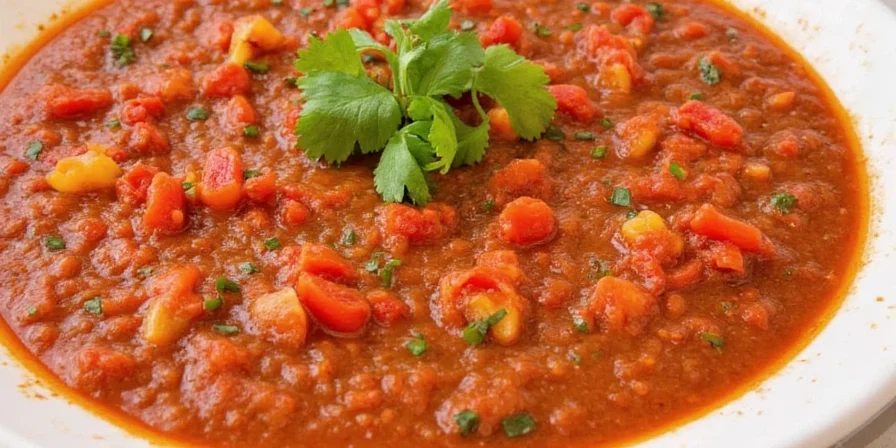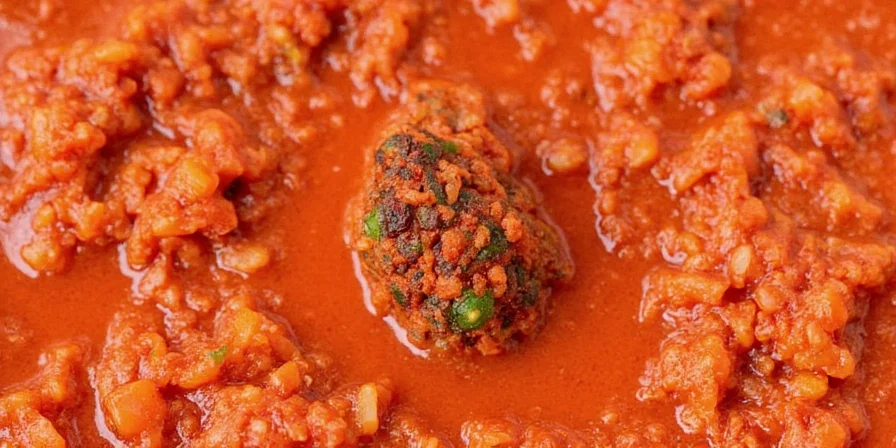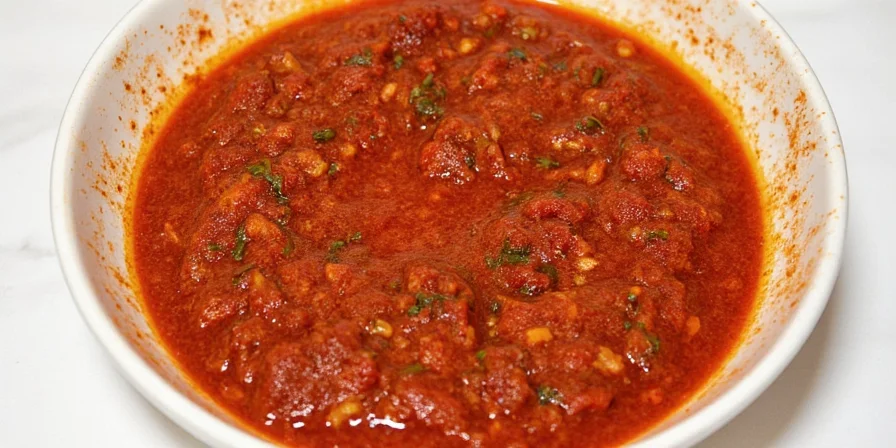Table of Contents
- What Is Sofrito? (Quick Definition)
- Basic Sofrito Recipe: Step-by-Step Instructions
- How to Fix Bitter Sofrito (Immediate Solution)
- Core Ingredients Breakdown: Ratios & Substitutions
- 7 Pro Chef Tips for Perfect Sofrito Every Time
- How Long Sofrito Lasts: Refrigerator vs Freezer Storage
- Regional Sofrito Variations Compared (Spain, Puerto Rico, Mexico)
- Sofrito Troubleshooting Guide
What Is Sofrito? (Quick Definition)
Sofrito is a flavor foundation used in Mediterranean, Spanish, and Latin American cuisines made by slowly cooking aromatic vegetables. Unlike mirepoix (onion-carrot-celery), sofrito always includes tomatoes and garlic, creating a rich base for stews, rice dishes, and sauces. The critical difference is cooking technique: sofrito requires low-and-slow cooking (15-20 minutes) to develop deep flavor without browning, while mirepoix is typically sautéed quickly.
Immediate answer to most common search: To make basic sofrito, combine 1 diced onion, 4 minced garlic cloves, 1 diced bell pepper, and 2 cups chopped tomatoes. Cook over medium-low heat with 3 tablespoons olive oil for 15-20 minutes until thickened but not browned.
Basic Sofrito Recipe: Step-by-Step Instructions
Follow this foolproof method for restaurant-quality sofrito at home:
- Prep ingredients uniformly: Finely dice 1 yellow onion (½ cup), 4 garlic cloves (1 tbsp minced), 1 bell pepper (½ cup), 2 cups Roma tomatoes
- Heat oil properly: Warm 3 tbsp extra-virgin olive oil in heavy skillet over medium-low heat (325°F)
- Add in sequence: Onions first (5 min), then peppers (3 min), garlic (2 min), finally tomatoes
- Cook with precision: Stir every 2 minutes for 15-20 minutes until thickened to jam-like consistency
- Season strategically: Add 1 tsp salt midway through cooking, never at beginning
- Cool properly: Remove from heat and cool 10 minutes before storing or using

How to Fix Bitter Sofrito (Immediate Solution)
Bitter sofrito is almost always caused by burned garlic or overcooked peppers. Fix it in 60 seconds:
- For mild bitterness: Stir in 1 tsp sugar or 2 tbsp grated carrot and cook 2 more minutes
- For severe bitterness: Transfer to clean pan with 2 tbsp fresh oil, discard any browned bits
- Prevention tip: Add garlic only after onions become translucent (5 minutes in), never at start
- Critical mistake: Cooking over medium-high heat - sofrito requires medium-low (325°F) max
Core Ingredients Breakdown: Ratios & Substitutions
The perfect sofrito ratio varies by cuisine. These tested measurements prevent common mistakes:
| Cuisine Type | Onion:Pepper:Tomato Ratio | Essential Additions | Common Mistakes to Avoid |
|---|---|---|---|
| Spanish | 1:0.5:1 | 1 tsp smoked paprika, no cilantro | Using sweet paprika instead of smoked |
| Puerto Rican | 1:1:0.5 | 10 culantro leaves, 2 tsp annatto oil | Substituting cilantro for culantro |
| Mexican | 1:0.75:0.75 | 1 jalapeño, 1 tsp cumin | Overcooking tomatoes into wateriness |
| Vegetarian Mole Base | 1:0.5:1.5 | 2 tbsp tomato paste, 3 dried mushrooms | Not cooking tomato paste sufficiently |

7 Pro Chef Tips for Perfect Sofrito Every Time
- Temperature control: Use infrared thermometer to maintain 325°F - any higher causes bitterness
- Garlic timing: Add garlic only after onions become translucent (5 minutes in), never at start
- Tomato preparation: Remove seeds from Roma tomatoes to prevent watery sofrito
- Salt strategy: Add half salt at 7 minutes, rest at 12 minutes for optimal flavor development
- Oil selection: Use avocado oil (smoke point 520°F) for high-heat applications
- Freezing method: Portion in silicone ice cube trays, cover with olive oil before freezing
- Revival technique: When using frozen, add 1 tsp water and warm gradually over low heat
How Long Sofrito Lasts: Refrigerator vs Freezer Storage
Proper storage prevents flavor degradation and food safety issues:
| Storage Method | Maximum Duration | Quality Indicators | Critical Steps |
|---|---|---|---|
| Room Temperature | 2 hours | Surface film developing | Never store longer than 2 hours |
| Refrigerated (glass jar) | 5 days | Separation of oils | Leave ½ inch headspace, top with olive oil layer |
| Freezer (ice cube tray) | 6 months | No texture changes | Cover with oil before sealing, use within 3 months for best flavor |
| Vacuum sealed | 8 months | Maintains original color | Cool completely before sealing, freeze flat |

Regional Sofrito Variations Compared (Spain, Puerto Rico, Mexico)
Key differences that impact flavor profile and dish compatibility:
- Spanish sofrito: Must include tomato paste cooked until "oil rings" appear (8-10 minutes). Critical for paella - without this step, rice becomes gummy.
- Puerto Rican sofrito: Requires culantro (not cilantro) and annatto oil. Substituting cilantro creates off-flavors that develop after 24 hours.
- Mexican sofrito: Raw tomatoes must be roasted first for authentic mole. Canned tomatoes create overly acidic results.
- Italian soffritto: Never includes tomatoes - equal parts onion, celery, carrot. Mistakenly called sofrito in English.
Sofrito Troubleshooting Guide
Why is my sofrito bitter?
Bitterness comes from burned garlic or overcooked peppers. Fix: Transfer to clean pan with fresh oil, stir in 1 tsp sugar. Prevention: Cook at medium-low (325°F max), add garlic only after onions soften (5 minutes in).
Can I make sofrito without tomatoes?
Yes, for Puerto Rican style: use 1 onion, 1 bell pepper, 10 culantro leaves, 4 garlic cloves, 2 tsp annatto oil. For Mexican style: substitute roasted red peppers for tomatoes. Never omit tomatoes in Spanish sofrito - it becomes mirepoix.
How do I thicken watery sofrito?
Cook uncovered for additional 5-7 minutes while stirring constantly. For immediate fix: stir in 1 tbsp tomato paste and cook 2 more minutes. Prevention: Remove tomato seeds before cooking and use Roma tomatoes (less water content).
Does sofrito freeze well?
Yes, when frozen properly: cool completely, portion in ice cube trays, cover with olive oil layer, freeze solid before transferring to bags. Keeps 6 months. Thaw in refrigerator overnight - never microwave.










 浙公网安备
33010002000092号
浙公网安备
33010002000092号 浙B2-20120091-4
浙B2-20120091-4